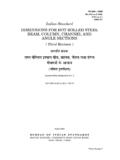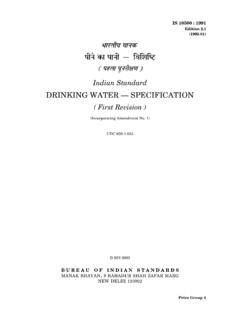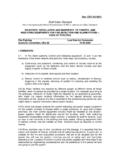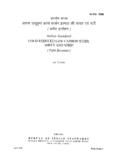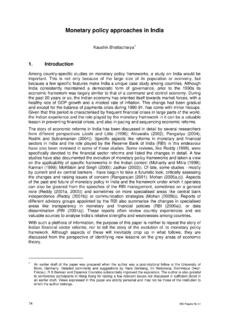Transcription of N S Vishwanathan: Basel III implementation - …
1 BIS central bankers speeches 1 N S vishwanathan : Basel III implementation challenges for Indian banking system Inaugural address delivered by Mr N S vishwanathan , Executive Director of the Reserve Bank of India, on the occasion of the National Conference on Basel III implementation : challenges for Indian banking system , organised by The Associated Chambers of Commerce & Industry of India with support of National Institute of Bank Management (NIBM), Mumbai, 31 August 2015. * * * Assistance provided by Mr. Ajay Kumar Choudhary and Mr Rajnish Kumar in preparing this speech is gratefully acknowledged. Accompanying charts can be found at the end of the speech.
2 1. I am indeed privileged to be sharing the dais with stalwarts and thank ASSOCHAM for giving me this opportunity to speak on challenges in implementing Basel III in India. 2. Basel III framework was basically the response of the global banking regulators to deal with the factors, more specifically those relating to the banking system that led to the global economic crisis or the great recession. In the advanced economies, there was a huge fiscal cost for protecting the financial system, which those governments did not want a repeat of. The framework therefore sought to increase the capital and improve the quality thereof to enhance the loss absorption capacity and resilience of the banks, brought in a leverage ratio to contain balance sheet expansion in relation to capital, introduced measures to ensure sound liquidity risk management framework in the form of liquidity coverage ratio (LCR) and net stable funding ratio (NSFR), modified provisioning norms and of course enhanced disclosure requirements.
3 3. In India, Basel III capital regulation has been implemented from April 1, 2013 in phases and it will be fully implemented as on March 31, 2019. Further, we have also introduced Basel III Liquidity Coverage Ratio (LCR) to be implemented by banks in India from January 1, 2015 with full implementation being effective from January 1, 2019. We have issued draft guidelines on implementation of Net Stable Funding Ratio (NSFR). We are also working on other areas of evolving regulations, especially those which are of critical importance from Indian perspective. 4. As this event is on challenges in implementing Basel III let me begin with the assumption that there are challenges .
4 Any change, big or small, of whatever nature brings with it challenges . The issue one must look at is whether the challenges are as onerous as one would think them to be and whether the challenges are worth facing up to. 5. The first element in this debate was whether we needed Basel III at all for a country like India. On this, Dr. Subba Rao, the then Governor of RBI1 made an interesting point and I quote him: One view, although not explicitly spelt out in that form, is that India need not adopt Basel III, or should adopt only a diluted version of it, so as to balance the benefits against the putative costs. To buttress this view, it is argued that Basel III is designed as a corrective for advanced economy banks which had gone astray, oftentimes taking advantage of regulatory gaps and regulatory looseness, and that Indian banks which remained sound through the crisis should not be burdened with the onerous obligations of Basel III.
5 1 Basel III in International and Indian Contexts Ten Questions We Should Know the Answers For Inaugural Address by Dr. Duvvuri Subbarao, Governor, Reserve Bank of India at the Annual FICCI IBA banking Conference at Mumbai on September 04, 2012. 2 BIS central bankers speeches The Reserve Bank does not agree with this view. Our position is that India should transit to Basel III because of several reasons. By far the most important reason is that as India integrates with the rest of the world, as increasingly Indian banks go abroad and foreign banks come on to our shores, we cannot afford to have a regulatory deviation from global standards.
6 Any deviation will hurt us both by way of perception and also in actual practice. The perception of a lower standard regulatory regime will put Indian banks at a disadvantage in global competition, especially because the implementation of Basel III is subject to a peer group review whose findings will be in the public domain. Deviation from Basel III will also hurt us in actual practice. We have to recognize that Basel III provides for improved risk management systems in banks. It is important that Indian banks have the cushion afforded by these risk management systems to withstand shocks from external systems, especially as they deepen their links with the global financial system going forward.
7 6. Once we take this postulate for granted, and in fact it needs to be, let us see what the challenges are: Capital What are the factors that lead to higher capital? 7. The first set of Basel III reforms agreed in later part of 2010 tackled the issue of numerator part of regulatory capital ratio. While minimum total capital requirements were kept unchanged at 8% of the RWA, the definition of various components of capital and its composition were thoroughly revised to ensure that capital performs its intended role of loss absorption. The minimum common equity requirement was raised from 2% level, before the application of regulatory adjustments, to after the application of stricter adjustments.
8 This meant that common equity requirement was effectively raised from 1% to The Tier 1 capital, which includes common equity and other qualifying financial instruments based on stricter criteria, was increased from 4% to 6%. It has also been agreed that there would be a capital conservation buffer of above the regulatory minimum requirement to be met with common equity. This effectively increases the total capital requirements from present 8% to In our case, the level of capital increases from 9% to , if capital conservation buffer is taken into account. In this context, it may be pertinent to note that post-crisis, major banks in advanced economies have raised their capital adequacy level significantly.
9 In general, globally banks have raised their CET1 ratio by almost 400 bps during last four years. And importantly, this is mainly by way of fresh infusion of equity capital. A comparative capital position of major Indian banks vis- -vis major global banks as indicated in graph 1. As may be appreciated, capital levels of our banking system need to go up significantly if our major banks have to compete globally. During recent years, the capacity of banks specifically, for the PSBs to generate capital internally have adversely affected mainly due to sharp deterioration in the asset quality. At the same time, banks have not made concerted efforts to shore up their capital level outside of the usual budgetary support.
10 After the phased-in implementation of Basel III, the RBI apprised the Government of India on the need to initiate appropriate measures to ensure that PSBs have plans and a well-defined strategy for meeting the capital requirements from a medium-term perspective. In this context, it is heartening to note that Government has initiated several measures such as allowing PSBs to access market to raise capital subject to ensuring minimum shareholding of the Government of 52% and recent unleashing of a plan for revamping PSBs called Indra dhanush These measures show the intent and commitment of Government to provide additional budgetary support to these banks to ensure that PSBs remain adequately capitalized to support BIS central bankers speeches 3 economic growth.










